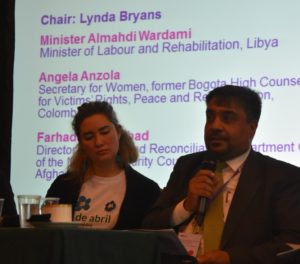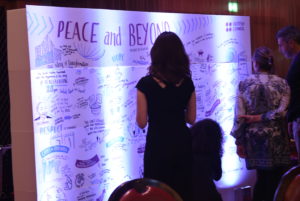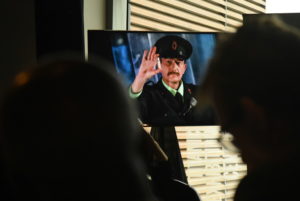What, I wondered, would Farhadullah Farhad feel about this?
In these city-centre aftermaths there’s always a tight knot of men, close to the camera, clutching at one another as they twist this way and that, distraught. Here, a sturdy, bearded man in white, a man in the prime of life, flings his hands heavenward, head back, body arching, as he howls, and howls and… CUT. He’s gone from my screen. But not from my memory, where his agony replays itself when I recall the 22nd April in Kabul, where more than 30 people were killed by a suicide bomber. They died for a prosaic reason. They were queuing to register to vote.
What would Mr Farhad feel?
On the morning of 12th April in Belfast City Hall I sat within feet of him at the British Council’s Peace and Beyond conference, as he described government efforts to rebuild democratic structures in Afghanistan. He is the Director of the Peace and Reconciliation Department at the Office of the National Security Council.

Farhadullah Farhad, right
Sombrely, he detailed the challenges and the dogged persistence needed, even to make ‘dialogue meetings’ possible. It was a glimpse into the bureaucracy of peace-building via details about the removal of travel bans or sanctions and the provision of passports − simply to get opponents to the table. But this apparent mundanity is in fact an exercise of the imagination. To achieve encounter, inflexibilities have to accommodate themselves to realities; the unthinkable has to be thought.
So when I saw that man in white convulsing in grief and read that a witness to the attack had said, “Now we know the government cannot protect us we have to get armed to protect ourselves” I remembered Mr Farhad’s efforts to persuade his fellow citizens that democracy works; the apparent fragility of the slow build towards justice by means of electoral representation compared to the apparent swift effectiveness of weapons, and the dilemma of the individual in every conflict zone: where do I place my trust?
Peace is built by people, not by machines. The Peace and Beyond conference brought us close to some of those people and they are, actually, very like ourselves: sometimes laughing, sometimes looking weary or perplexed. So that man in white, and Mr Farhad, and me… in it together. Somehow.
On Mr Farhad’s right was Ms Angela Anzola, Secretary for Women and Gender Equality, and former High Counsellor for Victims’ Rights, Peace and Reconciliation in Bogota, Colombia. She spoke of the nine million victims of the country’s fifty-year civil war.
Nine million.
Nine million out of a population of forty-nine million. She outlined the efforts not only to create a peace but one which recognizes the needs of women. How close, I wondered, have we come to that goal ourselves?
Alongside her, Mr Almahdi Wardami, Libya’s Minister of Labour and Rehabilitation, sketched for us the geographical and ethnic complexities of his vast country so that when he spoke, with a quiet precision, of north and south, I sensed something of the scale of the challenges and of how he carried his country’s richness and its fractures, not as an intellectual, logistical weight but as flesh of his flesh.
It is this embodiment of a country’s crisis and of its potential that struck me with all the speakers at this conference. Something of each place seemed to take form in front of me so that I experienced a taste of these 28 countries I may never visit: South Africa, the Philippines, Mexico, Lebanon…
I was struck by the sad similarities with Northern Ireland. That remark of the Kabul witness – hadn’t I heard that in my own troubled hometown? It was often asserted at the conference that each conflict presents a unique blend of certain essential ingredients: injustice, resource scarcity, lack of redress, inadequate politics. But to hear, over and again, how people have organised themselves to opt away from violence and towards hope was to be offered an inoculation against cynicism, a booster in a realpolitik which has not lost sight of compassion.

Peace and Beyond conference ideas board
There was consensus that peace-building cannot be left to politicians alone. The agents mentioned in the crucial matrix were politicians; former paramilitaries; civic leaders such as mayors and councillors; communities; specific groups for, say, victims or women, and then – and much more nebulous − the individual, the “ordinary person”.
Outside the matrix?
Vicky Cosstick, in her overview of the conference and other Good Friday Agreement commemorations for Northern Slant, asserts, “In the end, the peace will be made by the thousands of unsung heroes working on the ground, and by victims themselves as they inch their way towards self-acceptance, and acceptance of the other.”
The group within the matrix which most interests me is the one composed of all those who appear to be outside it. These are not politicos at any level, or former paramilitaries or members of any formal group, or even victims (depending on how one defines that delicate category) and perhaps not even “unsung heroes”. These are the many citizens whose consent and engagement, we were assured repeatedly by delegates, is the sine qua non if peace is to take root.
But how can these ‘un-grouped’ people be reached, or reach each other?
At the workshop, ‘Arts in the Aftermath of Conflict’ we had a wonderful presentation by Lebanese architect, Mona El Hallak Ghaibeh. This was a love story. True to her professional calling, she loved a building back to life. She helped to rescue and restore the heavily damaged Barakat Building in Sodeco, Beirut, transforming it into ‘Beit Beirut’, the first publicly-funded museum in commemoration of the city which suffered so badly in the civil conflict. The ‘extra mile’ in this case, is that she not only reclaimed bricks and mortar but the essence of the lives of some of its former inhabitants.
Over the last 13 years she has painstakingly pieced together, from fragments recovered from the rubble, accounts of the people for whom the building was a home or workplace. The life of a dentist comes back into view through his receipts, his restored dental chair; a photographer’s work sees the light again when she digs out, develops and hangs up on display rolls of film from an abandoned studio. People gradually turn up to identify themselves in one image or another.
This is both impressive and questionable. Impressively determined, but what’s the point? Why spend years doing this?
I said it was a love story. Mona el Hallak Ghaibeh and her collaborators are asserting what war tries to deny: that you, the individual, matter. War doesn’t care about your small life. Those who wage it make decisions about what’s going to happen to your body without consulting you. There is no ‘voter registration’. You never get the chance to opt out. This project reached out to those average, non-combatant citizens. Returning to inspect the rescued photographs they literally see their past self, the one the war stole.
This project, and others like it which she outlined, assert that the past matters and is not to be jettisoned in favour of some putative ‘new deal’. The past has to be honoured. The value of what has been lost has to be acknowledged. The violence didn’t come from nowhere. Such projects interrogate not only the individual’s worth and suffering but also the responsibility the individual may bear for colluding, directly or indirectly, with the causes of the conflict.

A still from Kabosh production ‘Green and Blue’
One hears sometimes in Northern Ireland the ‘everything was all right before all this started’ trope, as though the Troubles fell from a clear blue sky. Our own memories need to be both respected and fact-checked.
Theatre has a particular talent for this. In the same session, Paula McFetridge, Artistic Director of Kabosh spoke with a refreshingly grounded zest about the delicate business of creating theatre from the lived experience of interviewees, often the “ordinary people”. A not uncommon reaction to the finished work, she told us, is, “I now exist. You told my story. I now live.” This is another type of resurrection or restoration. “Those who don’t value what we do,” she said, “call this mere ‘anecdote’.”
I appreciated her assertion of the need to pay attention not only to the young but to “the generation who are between forty and sixty… the unsexy generation who have suppressed conversations about it (the Troubles) because they’ve been getting on with things.” Being in that age band myself, I agree, but particularly with an eye to those “un-grouped” people.
Is it the case that across the board there is too speedy a move to do cross-community work and not enough attention to the individual who is expected to move forward in time with the political process but with almost no comparable support? And, as Paula McFetridge asserted, there ought not to be any imposition of progress: “all individuals within your society are not ready to hear the same stories at the same time.” It cannot be a question of forcing people to act.
Immediately before the Peace and Beyond conference I attended Building Community Together an event at which the Catholic Bishop of Raphoe, Alan McGuckian challenged, in the strongest terms, any fellow Christian who is resting content with ‘a good enough peace’.
This, in my view, is a key issue for this period of our peace process: that we have grown used to our version of normal in which ‘acceptable levels’ of violence have mutated from keeping the lid on everyday murder to tolerating both a polarised political practice (which threatens to undermine the common ground as soon as it begins to solidify) and the absence of a functioning government. But it’s ‘good enough’. The buses run. The apparatus of surveillance is almost invisible.
At the Building Community Together weekend, Christian attendees were asked to attend a Sunday service at a denomination other than their own. A woman from the Republic of Ireland subsequently enthused to me about her experience. “It’s the first time I’ve been in a Protestant church since 2000.” I had thought her someone active in a cross-community way and when I expressed surprise she said pleasantly, “Well, you see, I don’t know any Protestants.” Couldn’t she, I asked (struggling to keep my amazement within bounds) have gone looking for some?
And who should I ‘look for’? Who is it I am failing to reach out to? What am I tolerating? And, remember, a person my age has been here before. I will never forget that sense, in the early days of our conflict, of the ground shifting beneath the feet of the grown-ups, who looked puzzled and fearful as the ‘good enough’ ground shifted beneath them.
The British Council is evaluating what its next step should be in order to build on the very positive reactions from conference attendees. This was a high- level conference. Attendance was open but my impression was that there were few delegates not attached to an institution. I recommend taking the contents ‘to the street’ in some way. Perhaps via a distillation of some of the impressive projects featured at the conference. Who is it that the British Council should ‘look for’, their least likely allies? Maybe Peace and Beyond should be taken to them.
And my question about the ‘un-grouped’, among whom I count myself? The only answer I can find is for myself: maybe this category is my Barakat Building or my theatre. This is my version of Vicky Cosstick’s ‘on the ground’, the ground where I can build − by interrogating my attitudes and assumptions; by uprooting the seeds that war planted in me which continue to bear fruit in cynicism or complacency; by valuing and inhabiting the role in peace-building which life has given to me.
Am I right?
